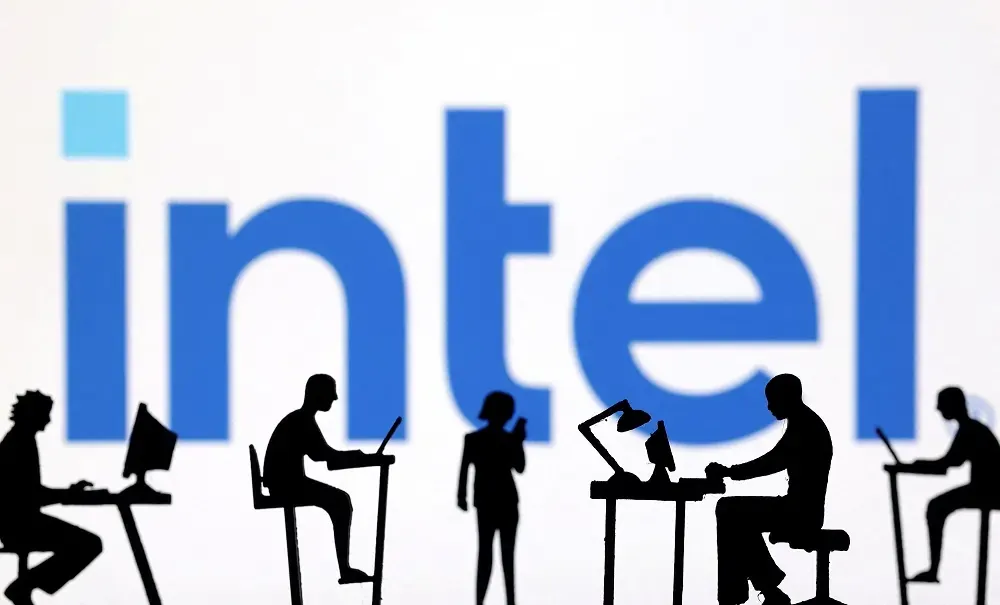
(Reuters) -Intel was set to erase about $35 billion in stock market value on Friday in potentially its worst selloff ever after it suspended dividend and slashed workforce to fund a costly turnaround for its chip-making business.
The company’s stock fell about 28% after Intel late on Thursday forecast quarterly revenue below estimates and announced 15% job cuts, raising worries about its ability to catch up with Taiwan’s TSMC and other chipmakers.
“Intel’s issues are now approaching the existential in our view,” Bernstein analyst Stacy Rasgon said.
He said there would be “going concern” talks in other circumstances, but Intel could add $40 billion in cash to its balance sheet by the end of 2025 through the moves, as well as subsidies and partner contributions.
“Intel will survive (in some form) to continue the fight,” Rasgon said.
Shares of other chip firms also fell, with Arm, Micron Technology, GlobalFoundries and U.S.-listed shares of TSMC trading down between 2.8% and 6.7%.
Wall Street darling Nvidia was 2% lower after a report about an investigation by the U.S. Department of Justice.
‘FORGOTTEN HORSEMAN’
Santa Clara-based Intel was once the world’s leading chipmaker, with the “Intel Inside” logo a valuable marketing feature on personal computers in the 1980s and 90s.
Part of the dotcom era’s Four Horsemen – along with Cisco Systems, Microsoft and Dell – Intel’s stock market value peaked at nearly $500 billion in 2000 before slumping that year and never fully recovering.
It continued to dominate in hefty PC chips, but was caught off foot by the launch of Apple’s iPhone in 2007 and other mobile devices that demanded lower power and less pricey processors.
If Friday’s losses hold, Intel’s market value would fall to about $90 billion, equivalent to less than 5% of Nvidia’s and about 40% of Advanced Micro Devices’, the two PC chipmakers it heavily dominated for decades until recently.
The selloff was also set to leave Intel worth less than Applied Materials and Lam Research, companies that supply equipment for Intel’s fabrication plants.
“Eliminating the dividend may pressure the share price because it will knock Intel out of any ETFs, indices and fund strategies that only include dividend payers,” said Michael Schulman, chief investment officer of Running Point Capital.
“Intel has been one of the forgotten horsemen of technology the last couple decades. Never overtaking its year 2000 highs and struggling to get earnings back to where they were before the AI revolution.”
Its server chip business has been taking a hit for several years as companies prioritize spending on AI chips, where it lags rival Nvidia, which has become one of the world’s most valuable firms thanks to booming demand for its processors.
To regain its manufacturing edge, Intel is planning to spend $100 billion across four U.S. states to build and expand factories after securing $19.5 billion in federal grants and loans.
Its turnaround plan depends on persuading outside companies to use its manufacturing services. But analysts say the push to energize contracting foundry business could take years. For now, it is increasing Intel’s costs and pressuring profit margins.
At least 14 analysts lowered their price target on Intel’s stock after the results, pushing down the median PT to $28. Its shares were trading at a more than 11-year low of $20.6 on Friday.
The stock has a 12-month forward price-to-earnings ratio of 18.62, compared with Nvidia’s 32.15 and AMD’s 29.42.
(Reporting by Noel Randewich in Oakland, California, and Aditya Soni in Bengaluru; Additional reporting by Arsheeya Bajwa in Bangalore; Editing by Mrigank Dhaniwala and Arun Koyyur)


